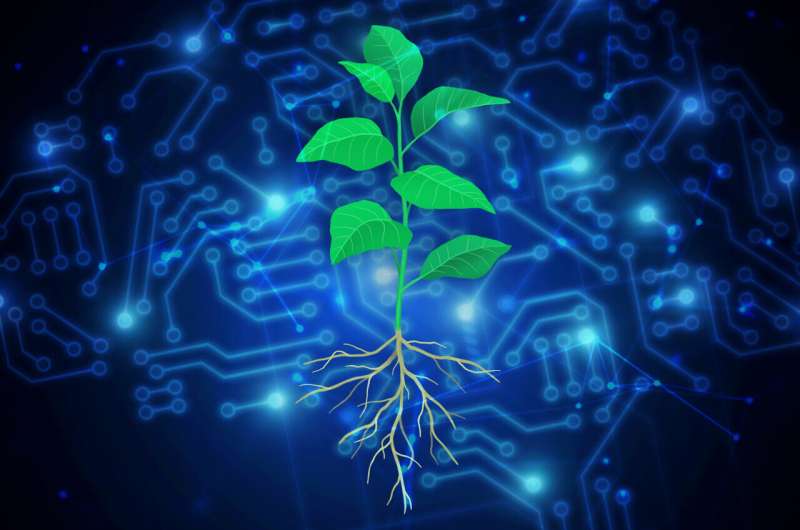

The Intergovernmental Panel on Weather Alter (IPCC) has declared that eliminating carbon from the ambiance is now important to combating weather change and limiting international temperature rise. To assistance these initiatives, Salk Institute researchers are harnessing plants’ pure potential to attract carbon dioxide out of the air by optimizing their root devices to retail store extra carbon for a for a longer time time period of time.
To design these local weather-saving vegetation, scientists in Salk’s Harnessing Vegetation Initiative are utilizing a complex new investigation instrument named SLEAP—an simple-to-use synthetic intelligence (AI) software program that tracks a number of capabilities of root expansion. Made by Salk Fellow Talmo Pereira, SLEAP was at first made to keep track of animal movement in the lab. Now, Pereira has teamed up with plant scientist and Salk colleague Professor Wolfgang Busch to utilize SLEAP to plants.
In a review posted in Plant Phenomics, Busch and Pereira debut a new protocol for using SLEAP to examine plant root phenotypes—how deep and large they improve, how significant their root methods develop into, and other bodily features that—prior to SLEAP—were cumbersome to measure. The software of SLEAP to vegetation has by now enabled researchers to establish the most intensive catalog of plant root procedure phenotypes to day.
What’s more, monitoring these bodily root procedure qualities assists researchers come across genes affiliated with those people attributes, as well as no matter if several root qualities are decided by the exact genes or independently. This enables the Salk workforce to establish which genes are most effective to their plant types.
“This collaboration is certainly a testament to what makes Salk science so specific and impactful,” suggests Pereira. “We are not just ‘borrowing’ from unique disciplines—we’re genuinely putting them on equivalent footing in get to make a little something better than the sum of its elements.”
Prior to utilizing SLEAP, tracking the physical properties of equally crops and animals required a lot of labor that slowed the scientific approach. If scientists needed to assess an picture of a plant, they would need to manually flag the pieces of the impression that had been and weren’t plant—frame by body, section by section, pixel by pixel. Only then could older AI products be applied to system the picture and acquire facts about the plant’s construction.
What sets SLEAP apart is its unique use of equally pc eyesight (the skill for pcs to understand photos) and deep finding out (an AI approach for training a computer system to find out and do the job like the human brain). This mix makes it possible for scientists to approach photographs with no transferring pixel by pixel, in its place skipping this intermediate labor-intensive move to jump straight from graphic input to defined plant options.
“We designed a sturdy protocol validated in numerous plant styles that cuts down on assessment time and human error, whilst emphasizing accessibility and ease-of-use—and it essential no changes to the precise SLEAP program,” says initially author Elizabeth Berrigan, a bioinformatics analyst in Busch’s lab.
Without having modifying the baseline know-how of SLEAP, the researchers produced a downloadable toolkit for SLEAP named sleap-roots (accessible as open up-supply computer software here). With sleap-roots, SLEAP can process biological characteristics of root methods like depth, mass, and angle of progress.
The group examined the sleap-roots offer in a range of crops, such as crop vegetation like soybeans, rice, and canola, as perfectly as the model plant species Arabidopsis thaliana—a flowering weed in the mustard household. Throughout the variety of crops trialed, they located that the novel SLEAP-primarily based method outperformed present practices by annotating 1.5 periods more rapidly, training the AI product 10 times faster, and predicting plant composition on new facts 10 situations speedier, all with the very same or much better precision than right before.
Collectively with significant genome sequencing endeavours for elucidating the genotype knowledge in significant numbers of crop kinds, these phenotypic info, this kind of as a plant’s root procedure escalating especially deep in soil, can be extrapolated to comprehend the genes liable for creating that in particular deep root process.
This step—connecting phenotype and genotype—is critical in Salk’s mission to build plants that keep on to a lot more carbon and for longer, as individuals crops will need to have root methods created to be further and a lot more sturdy. Utilizing this accurate and effective software will allow for the Harnessing Vegetation Initiative to join attractive phenotypes to targetable genes with groundbreaking simplicity and pace.
“We have presently been able to build the most in depth catalogue of plant root program phenotypes to day, which is actually accelerating our investigation to build carbon-capturing plants that struggle weather change,” claims Busch, the Hess Chair in Plant Science at Salk. “SLEAP has been so easy to use and use, thanks to Talmo’s skilled application design and style, and it can be likely to be an indispensable device in my lab moving forward.”
Accessibility and reproducibility were being at the forefront of Pereira’s intellect when creating equally SLEAP and sleap-roots. For the reason that the software program and sleap-roots toolkit are free of charge to use, the researchers are fired up to see how sleap-roots will be applied about the world. Currently, they have begun discussions with NASA scientists hoping to employ the resource not only to help guideline carbon-sequestering vegetation on Earth, but also to study vegetation in space.
At Salk, the collaborative team is not nonetheless completely ready to disband—they are by now embarking on a new problem of analyzing 3D facts with SLEAP. Efforts to refine, extend, and share SLEAP and sleap-roots will proceed for years to arrive, but its use in Salk’s Harnessing Vegetation Initiative is now accelerating plant styles and aiding the Institute make an impression on weather transform.
Other authors include Lin Wang, Hannah Carrillo, Kimberly Echegoyen, Mikayla Kappes, Jorge Torres, Angel Ai-Perreira, Erica McCoy, Emily Shane, Charles Copeland, Lauren Ragel, Charidimos Georgousakis, Sanghwa Lee, Dawn Reynolds, Avery Talgo, Juan Gonzalez, Ling Zhang, Ashish Rajurkar, Michel Ruiz, Erin Daniels, Liezl Maree, and Shree Pariyar of Salk.
More info:
Elizabeth M. Berrigan et al, Speedy and Productive Root Phenotyping via Pose Estimation, Plant Phenomics (2024). DOI: 10.34133/plantphenomics.0175
Citation:
Synthetic intelligence assists experts engineer vegetation to battle local weather adjust (2024, April 24)
retrieved 15 May 2024
from https://phys.org/information/2024-04-synthetic-intelligence-researchers-local weather.html
This document is subject to copyright. Apart from any truthful dealing for the intent of private research or investigate, no
element may well be reproduced devoid of the published permission. The content is presented for facts needs only.







